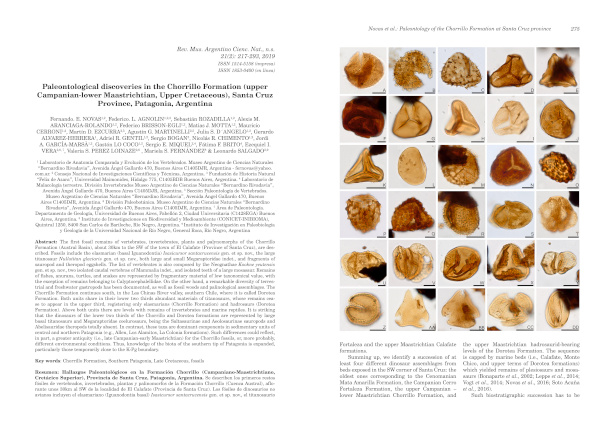Paleontological discoveries in the Chorrillo Formation (upper Campanian-lower Maastrichtian, Upper Cretaceous), Santa Cruz Province, Patagonia, Argentina
Resumen
The first fossil remains of vertebrates, invertebrates, plants and palynomorphs of the Chorrillo Formation (Austral Basin), about 30km to the SW of the town of El Calafate (Province of Santa Cruz), are described. Fossils include the elasmarian (basal Iguanodontia) Isasicursor santacrucensis gen. et sp. nov., the large titanosaur Nullotitan glaciaris gen. et sp. nov., both large and small Megaraptoridae indet., and fragments of sauropod and theropod eggshells. The list of vertebrates is also composed by the Neognathae Kookne yeutensis gen. et sp. nov., two isolated caudal vertebrae of Mammalia indet., and isolated teeth of a large mosasaur. Remains of fishes, anurans, turtles, and snakes are represented by fragmentary material of low taxonomical value, with
the exception of remains belonging to Calyptocephalellidae. On the other hand, a remarkable diversity of terrestrial and freshwater gastropods has been documented, as well as fossil woods and palinological assemblages. The Chorrillo Formation continues south, in the Las Chinas River valley, southern Chile, where it is called Dorotea Formation. Both units share in their lower two thirds abundant materials of titanosaurs, whose remains cease to appear in the upper third, registering only elasmarians (Chorrillo Formation) and hadrosaurs (Dorotea Formation). Above both units there are levels with remains of invertebrates and marine reptiles. It is striking that the dinosaurs of the lower two thirds of the Chorrillo and Dorotea formations are represented by large
basal titanosaurs and Megaraptoridae coelurosaurs, being the Saltasaurinae and Aeolosaurinae sauropods and Abelisauridae theropods totally absent. In contrast, these taxa are dominant components in sedimentary units of
central and northern Patagonia (e.g., Allen, Los Alamitos, La Colonia formations). Such differences could reflect, in part, a greater antiquity (i.e., late Campanian-early Maastrichtian) for the Chorrillo fossils, or, more probably,
different environmental conditions. Thus, knowledge of the biota of the southern tip of Patagonia is expanded, particularly those temporarily close to the K-Pg boundary.
Descargas

Descargas
Archivos adicionales
Publicado
Número
Sección
Licencia
Los autores/as que publiquen en esta revista aceptan las siguientes condiciones:- Los autores/as conservan los derechos de autor y ceden a la revista el derecho de la primera publicación, con el trabajo registrado con la licencia de atribución de Creative Commons, que permite a terceros utilizar lo publicado siempre que mencionen la autoría del trabajo y a la primera publicación en esta revista.
- Se permite y recomienda a los autores/as a publicar su trabajo en Internet (por ejemplo en páginas institucionales o personales), ya que puede conducir a a una mayor y más rápida difusión del trabajo publicado.
